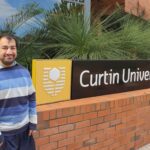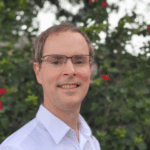On a scorching summer’s day, Curtin student Ryan Borrett dons a thick puffer jacket, beanie and gloves and slips into a secret campus location. Standing in the windowless, near-freezing room, he gets ready to catalogue one of the world’s rarest film archives.
The archives, impeccably preserved, are a precious trove of information that uncover the lives of the Fore people of Papua New Guinea, and detail their battle against the deadly brain disease, kuru.
“It’s hard to overstate the significance of the archives,” says Borrett. “Kuru was a neurodegenerative disease that baffled the medical community for decades. The films explore the impact of kuru on the Fore community and reveal a way of life that has all but disappeared.”

For months Borrett has been working to catalogue and inventory the 1,060 films that were produced by more than fifty filmmakers across half a century.
“Curtin constructed a purpose-built archive to house the collection,” he explains. “The films are kept in a cool room at a constant 4–5°C to preserve and prolong the life of the footage.”
On the frontline in Papua New Guinea
Borrett has been working alongside Curtin Emeritus Professor Michael Alpers, a leading global expert on kuru.
Professor Alpers was a young medical student in Adelaide in the 1950s when he first came across the disease in a newspaper article.
“It was described as the ‘laughing death’ disease,” he explains. “The afflicted suffered from face and body contortions, tremors and an uncontrollable laugh. Eventually they lost the ability to speak and eat and all died within twelve months of onset.”
Professor Alpers set out to learn everything he could about the obscure illness. He discovered it was highly localised, yet it killed hundreds of people each year.
 In 1961, he relocated to the remote eastern highlands of Papua New Guinea to study the effects of the disease firsthand. It was a decision that would change the trajectory of his medical career.
In 1961, he relocated to the remote eastern highlands of Papua New Guinea to study the effects of the disease firsthand. It was a decision that would change the trajectory of his medical career.
Based in the remote village of Waisa with his wife and infant daughter, he built strong links with the community.
“I visited every hamlet,” he says. “I ate with people in their gardens and homes and made a big effort to learn everyone’s names. From the beginning there was mutual acceptance. We recognised our common humanity and moved on from there.”
Professor Alpers set up a clinic and employed assistants from the village to dress sores, give penicillin injections and keep records.
“We were kept very busy treating tropical ulcers and pneumonia,” he recalls. “I was also busy travelling to other kuru-affected villages.”
Camera obscura

Professor Alpers brought a large Bolex camera from Adelaide to film the Fore way of life and the impacts of kuru.
“I took the camera with me on all my trips,” he explains. “Not all patients were willing to be filmed but I used the camera whenever I could.”
Indeed, the camera was accidentally viewed by some patients as a miracle cure for kuru patients.
“There was an incident when I was asked to diagnose a prisoner who was showing symptoms of kuru. A fellow doctor and I examined the patient and found his symptoms fluctuated and were not progressive. We diagnosed his ‘kuru’ as hysterical.
“We visited him in his village upon his release and he showed the same hysterical features, though less florid than before. Later, we learned our ‘kuru’ patient had fully recovered, which was no surprise to us.
“But suddenly I received numerous requests to visit villages all over the kuru region. I was heartened by this public surge of support for my work. It took me a while to realise that people wanted me to use my camera to heal their relatives in the same way they assumed I had ‘cured’ the former prisoner!”
A major breakthrough
Living in the village, Professor Alpers became intimately familiar with the symptoms of kuru and the disease’s trajectory but the cause was still a mystery.
“It was a very difficult time emotionally,” he recalls. “I was very close to the families and it was desperately sad to see the suffering. But it only made me more determined to eradicate the disease.”
With the permission of families, he began conducting autopsies. It was through this work that Professor Alpers made a momentous breakthrough. In collaboration with medical researcher and Nobel Prize-winner Dr Carleton Gadjusek, and colleagues in the US, he discovered kuru was transmitted through diseased brain tissue.
But it was still unclear how the infection was transmitted from person to person. Consulting his extensive notes, he realised that no child born after 1960 had been diagnosed with the illness.
Further research revealed a key link.
In the 1950s local mortuary practices had officially been banned. Prior to the ban, for spiritual and cultural reasons, it had been common practice, particularly among women and children, to consume the bodies of loved ones upon their death.
This was how kuru had spread.
“It was a significant breakthrough,” says Professor Alpers. “It explained why the illness had predominantly impacted women and children and why it had not spread beyond the Fore community.”
With the ban in place, the number of cases of kuru slowed down, but the disease’s unusually long incubation period meant there were still frequent cases as late as the 1990s. The last patient died of kuru in 2009.
The transmissible agent in the diseased brain tissue was later identified as an infectious, self-propagating protein called a ‘prion’, the same agent found in Creutzfeldt-Jakob Disease and its variant, commonly referred to as ‘mad cow disease’.
Kuru, Curtin and the future of the collection
 Professor Alpers has remained heavily involved with the Fore community and kuru research over the decades. His films were included by Gadjusek in the collection known as the Melanesian Film Archive. The collection was assembled at the US’ National Institutes of Health, the world’s largest biomedical agency. In 2005, the archive was transferred to Curtin University in the care of Professor Alpers.
Professor Alpers has remained heavily involved with the Fore community and kuru research over the decades. His films were included by Gadjusek in the collection known as the Melanesian Film Archive. The collection was assembled at the US’ National Institutes of Health, the world’s largest biomedical agency. In 2005, the archive was transferred to Curtin University in the care of Professor Alpers.
With the work Borrett has completed, Professor Alpers and colleagues at Curtin, including archivist Elizabeth McKenzie, hope to secure funding to digitise select footage and make it widely available.
Borrett says he has learned a huge amount from working on the collection.
“As a graduate of molecular genetics and biotechnology, I understand the importance of the footage from a public health perspective but I’ve also learned how vital it is to store and manage data correctly and the significance of capturing little details,” he says.
The health sciences graduate secured the opportunity to work on the collection through Curtin’s Earn While You Learn program.
“I would highly recommend the program to other students looking to boost their skills while studying,” he says. “I’m now studying honours and this experience has been so beneficial. Seeing the evolution of a disease from unknown to eradicated has been fascinating.
“It’s an incredible outcome for research and public health.”



